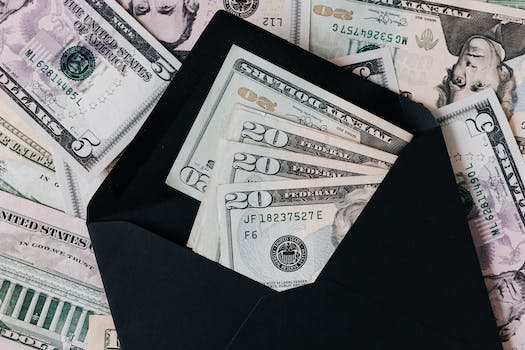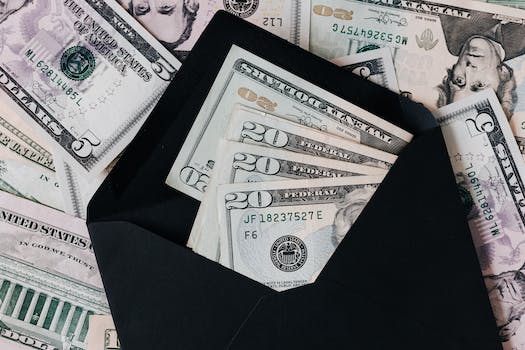How To Save Money Right Now
Introduction

Introduction: Saving money is an essential aspect of financial planning. It helps you to achieve your financial goals, build an emergency fund, and secure your future. However, saving money can be challenging, especially during tough economic times. In this article, we will discuss some practical tips on how to save money right now. These tips are easy to implement and can help you save money quickly.
10 Simple Ways to Cut Your Monthly Expenses
Are you looking for ways to save money right now? Whether you’re trying to pay off debt, build up your savings, or just live more frugally, there are plenty of simple steps you can take to cut your monthly expenses. Here are 10 ideas to get you started:
1. Cut the cord on cable TV. With so many streaming services available, you can still watch your favorite shows and movies without paying for a pricey cable package.
2. Cook at home more often. Eating out can be a major drain on your budget, so try to cook meals at home as much as possible. Not only is it cheaper, but it’s often healthier too.
3. Use coupons and promo codes. Before making any online or in-store purchases, do a quick search for coupons or promo codes that can help you save money.
4. Cancel subscriptions you don’t use. Are you paying for a gym membership you never use? Or a magazine subscription you never read? Cancel any subscriptions you don’t need or use regularly.
5. Shop around for insurance. Whether it’s car insurance, home insurance, or health insurance, it pays to shop around and compare rates from different providers.
6. Cut back on energy usage. Simple steps like turning off lights when you leave a room, using a programmable thermostat, and unplugging electronics when they’re not in use can all help you save money on your energy bills.
7. Buy generic brands. When shopping for groceries or household items, opt for generic or store-brand products instead of name-brand items. They’re often just as good, but much cheaper.
8. Use public transportation. If you live in an area with good public transportation, consider using it instead of driving your car. It can save you money on gas, parking, and maintenance.
9. DIY whenever possible. Instead of paying someone else to do things like cleaning, home repairs, or car maintenance, try to do it yourself. There are plenty of online tutorials and resources available to help you learn new skills.
10. Negotiate bills and fees. Don’t be afraid to negotiate with service providers like your cable company, internet provider, or cell phone carrier. You may be able to get a better deal or lower your monthly bill by simply asking.
By implementing these simple strategies, you can start saving money right now. Remember, every little bit counts, so even small changes can add up to big savings over time. So why not give it a try? Your wallet (and your future self) will thank you.
The Ultimate Guide to Couponing for Beginners
Are you looking for ways to save money right now? Couponing is a great way to do just that! It may seem overwhelming at first, but with a little bit of practice, you can become a pro in no time. Here is the ultimate guide to couponing for beginners.
First, start by collecting coupons. You can find them in newspapers, magazines, online, and even in-store. Look for coupons for products that you use regularly or that you would like to try. Don’t forget to check the expiration date and any restrictions on the coupon.
Next, organize your coupons. You can use a binder, a coupon wallet, or even just an envelope. Sort your coupons by category, such as food, household items, and personal care. This will make it easier to find the coupons you need when you are shopping.
Now it’s time to plan your shopping trip. Look at the weekly ads for your favorite stores and see what items are on sale. Match up your coupons with the sale items to maximize your savings. Don’t forget to check for any additional store coupons or promotions that you can use.
When you are at the store, be sure to stick to your list. It’s easy to get sidetracked by all the deals, but if you buy items that you don’t need, you are not really saving money. Use your coupons at the checkout and watch the savings add up.
Another way to save money is to stack coupons. Some stores allow you to use a manufacturer coupon and a store coupon on the same item. This can result in significant savings. Be sure to read the store’s coupon policy to see what is allowed.
If you are really serious about couponing, consider joining a couponing group or forum. You can learn from other couponers and share tips and deals. You may even find someone to trade coupons with.
Finally, don’t forget to be patient. Couponing takes time and practice. You may not see significant savings right away, but if you stick with it, you will start to see the benefits. Remember, every little bit counts.
In conclusion, couponing is a great way to save money right now. Start by collecting coupons, organizing them, and planning your shopping trip. Stick to your list and use your coupons at the checkout. Consider stacking coupons and joining a couponing group. And most importantly, be patient. With a little bit of effort, you can become a couponing pro in no time. Happy saving!
5 DIY Home Improvement Projects That Will Save You Money
Are you looking for ways to save money right now? One great way to do so is by tackling some DIY home improvement projects. Not only will you save money by doing the work yourself, but you’ll also increase the value of your home. Here are five DIY home improvement projects that will save you money.
1. Paint Your Walls
One of the easiest and most cost-effective ways to update your home is by painting your walls. A fresh coat of paint can transform a room and make it feel brand new. Plus, painting your walls yourself is much cheaper than hiring a professional. All you need is some paint, a roller, and a brush. You can even save money on paint by buying it in bulk or using coupons.
2. Install a Programmable Thermostat
If you’re looking to save money on your energy bills, consider installing a programmable thermostat. These thermostats allow you to set the temperature in your home based on your schedule. For example, you can set the temperature to be cooler during the day when you’re at work and warmer at night when you’re home. This can save you a significant amount of money on your energy bills each month.
3. Replace Your Light Fixtures
Replacing your light fixtures is another easy DIY home improvement project that can save you money. Old light fixtures can be inefficient and use a lot of energy. By replacing them with newer, more energy-efficient fixtures, you can save money on your energy bills. Plus, new light fixtures can give your home a fresh, updated look.
4. Install Low-Flow Showerheads and Faucets
Another way to save money on your water bills is by installing low-flow showerheads and faucets. These fixtures use less water than traditional ones, which can save you money on your monthly water bill. Plus, they’re easy to install yourself and can be found at most home improvement stores.
5. Insulate Your Attic
If you’re looking to save money on your heating and cooling bills, consider insulating your attic. A poorly insulated attic can cause your energy bills to skyrocket, as hot air escapes in the winter and cool air escapes in the summer. By insulating your attic, you can keep your home at a more consistent temperature and save money on your energy bills.
In conclusion, there are many DIY home improvement projects that can save you money right now. From painting your walls to insulating your attic, these projects are easy to do yourself and can make a big difference in your home’s energy efficiency and overall value. So why not tackle one of these projects this weekend and start saving money today?
How to Meal Plan and Save Money on Groceries
Are you looking for ways to save money right now? One of the easiest ways to cut down on expenses is by meal planning and saving money on groceries. Not only will this help you save money, but it can also lead to healthier eating habits and less food waste. Here are some tips on how to meal plan and save money on groceries.
First, take inventory of what you already have in your pantry, fridge, and freezer. This will help you avoid buying unnecessary items and ensure that you use up what you already have. Make a list of the items you need to buy and stick to it when you go grocery shopping. Avoid impulse purchases and stick to your budget.
Next, plan your meals for the week. This will help you avoid the temptation of eating out or ordering takeout, which can be expensive. Look for recipes that use similar ingredients to save money and reduce waste. You can also plan to cook larger portions and have leftovers for lunch or dinner the next day.
When you go grocery shopping, look for sales and discounts. Buy in bulk when possible, especially for non-perishable items like rice, pasta, and canned goods. Consider buying generic or store-brand items instead of name-brand products. They are often just as good and cost less.
Another way to save money on groceries is by buying seasonal produce. Fruits and vegetables that are in season are often cheaper and taste better. You can also buy frozen fruits and vegetables, which are often less expensive than fresh produce and last longer.
Consider joining a grocery store loyalty program or using coupons. Many stores offer discounts and rewards for frequent shoppers. You can also use apps like Ibotta or Checkout 51 to earn cash back on your purchases.
When you get home from the grocery store, take the time to properly store your food. This will help it last longer and reduce waste. Use airtight containers for leftovers and store fruits and vegetables in the crisper drawer of your fridge.
Finally, don’t be afraid to get creative with your meals. Use leftovers to make new dishes or try new recipes with ingredients you already have. This will help you save money and reduce food waste.
In conclusion, meal planning and saving money on groceries is a great way to cut down on expenses and lead a healthier lifestyle. By taking inventory of what you already have, planning your meals, looking for sales and discounts, buying seasonal produce, using coupons, properly storing your food, and getting creative with your meals, you can save money and reduce waste. Give it a try and see how much you can save!
The Benefits of Buying Used vs. New
Are you looking for ways to save money right now? One option to consider is buying used items instead of new ones. Not only can this save you money, but it can also have a positive impact on the environment. In this article, we will explore the benefits of buying used versus new.
First and foremost, buying used items is often much cheaper than buying new ones. Whether you are in the market for a car, furniture, or clothing, you can often find high-quality used items at a fraction of the cost of new ones. This can be especially beneficial if you are on a tight budget or trying to save money for other expenses.
In addition to saving money, buying used items can also be better for the environment. When you buy something new, it requires resources to produce and transport it to the store. By buying used, you are reducing the demand for new products and helping to reduce the amount of waste that ends up in landfills.
Another benefit of buying used items is that they often have a unique history or character that new items lack. For example, a vintage piece of furniture or a classic car can add a touch of personality to your home or garage. Additionally, buying used items can be a fun and rewarding experience, as you never know what treasures you might find.
Of course, there are some downsides to buying used items as well. For one, you may not be able to find exactly what you are looking for, or the item may not be in the best condition. However, with a little patience and persistence, you can often find high-quality used items that meet your needs.
When buying used items, it is important to do your research and shop around. Look for reputable sellers and check online reviews to ensure that you are getting a good deal. Additionally, be sure to inspect the item carefully before making a purchase, and ask the seller any questions you may have.
In conclusion, buying used items can be a great way to save money and reduce your environmental impact. Whether you are in the market for a car, furniture, or clothing, there are plenty of high-quality used items available at a fraction of the cost of new ones. So why not give it a try and see how much you can save?
7 Tips for Saving Money on Your Next Vacation
Are you planning your next vacation but worried about the expenses? Don’t worry, we’ve got you covered! Here are seven tips for saving money on your next vacation.
1. Plan ahead
Planning ahead is the key to saving money on your vacation. Start by researching the best deals on flights, hotels, and activities. Look for discounts and promotions that can help you save money. Also, consider traveling during the off-season when prices are lower.
2. Use travel rewards
If you have a credit card that offers travel rewards, use them to your advantage. You can earn points or miles for every dollar you spend, which can be redeemed for flights, hotels, and other travel expenses. Make sure to read the terms and conditions of your rewards program to maximize your savings.
3. Book a vacation package
Booking a vacation package can save you money on flights, hotels, and activities. Many travel companies offer package deals that include everything you need for your vacation. You can also save money by booking a package during the off-season.
4. Stay in a vacation rental
Staying in a vacation rental can be cheaper than staying in a hotel. You can rent a house or apartment for a fraction of the cost of a hotel room. Plus, you’ll have access to a kitchen, which can help you save money on food.
5. Cook your own meals
Eating out can be expensive, especially if you’re traveling with a family. Consider cooking your own meals instead. You can buy groceries at a local supermarket and prepare your own meals in your vacation rental. This can save you a lot of money in the long run.
6. Use public transportation
Using public transportation can be a great way to save money on your vacation. Instead of renting a car or taking taxis, use buses, trains, or subways to get around. This can be much cheaper than other transportation options.
7. Look for free activities
There are many free activities you can do on your vacation. Look for parks, museums, and other attractions that don’t charge admission fees. You can also take advantage of free walking tours or explore the city on your own.
In conclusion, saving money on your next vacation is possible if you plan ahead, use travel rewards, book a vacation package, stay in a vacation rental, cook your own meals, use public transportation, and look for free activities. By following these tips, you can enjoy your vacation without breaking the bank. Happy travels!
The Importance of Building an Emergency Fund and How to Start
Saving money is a crucial aspect of financial stability. However, it can be challenging to know where to start, especially if you’re living paycheck to paycheck. The good news is that there are simple steps you can take to start saving money right now. One of the most important things you can do is to build an emergency fund.
An emergency fund is a savings account that you can use to cover unexpected expenses, such as car repairs, medical bills, or job loss. Having an emergency fund can help you avoid going into debt or relying on credit cards to cover these expenses. It can also provide peace of mind knowing that you have a financial safety net in case of an emergency.
So, how do you start building an emergency fund? The first step is to set a savings goal. A good rule of thumb is to aim for three to six months’ worth of living expenses. This may seem like a lot, but it’s important to have enough savings to cover your basic needs in case of a job loss or other emergency.
Once you have a savings goal in mind, it’s time to start saving. One of the easiest ways to do this is to set up automatic transfers from your checking account to your savings account. You can choose how much you want to transfer each month, and it will happen automatically, so you don’t have to think about it.
Another way to save money is to cut back on unnecessary expenses. Take a look at your monthly expenses and see where you can make cuts. For example, you could cancel subscriptions you don’t use, eat out less often, or switch to a cheaper cell phone plan. Every little bit helps, and the money you save can go towards your emergency fund.
It’s also important to have a plan for how you will use your emergency fund. Make a list of potential emergencies and estimate how much they would cost. This will give you an idea of how much you need to save and what you will use the money for. It’s important to only use your emergency fund for true emergencies, so you don’t deplete your savings unnecessarily.
Finally, it’s important to keep your emergency fund separate from your other savings. This will help you avoid dipping into it for non-emergency expenses. Consider opening a separate savings account specifically for your emergency fund. This will make it easier to track your progress and keep your savings organized.
In conclusion, building an emergency fund is an essential step in saving money and achieving financial stability. By setting a savings goal, automating your savings, cutting back on unnecessary expenses, and keeping your emergency fund separate from your other savings, you can start building your emergency fund today. Remember, every little bit helps, and having a financial safety net can provide peace of mind and protect you from unexpected expenses.
Conclusion
Conclusion: To save money right now, it is important to create a budget, cut unnecessary expenses, and find ways to increase income. Small changes in daily habits can also make a big difference in saving money. It is important to stay disciplined and committed to the goal of saving money in order to achieve financial stability and security.







